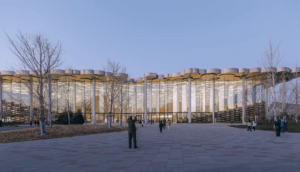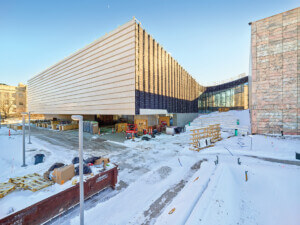Although the Snøhetta-designed SFMOMA expansion won’t open until mid-2016, there’s a lot going on behind the scenes. Earlier this month the museum promoted Jennifer Dunlop Fletcher to the Helen Hilton Raiser Curator of Architecture and Design and head of the Department of Architecture and Design. Dunlop Fletcher (who joined the museum as an assistant curator in 2007) co-curated the impressive Lebbeus Woods, Architect exhibition in 2013. AN spoke to her about the future of architecture and design in San Francisco and Silicon Valley.
The Architect’s Newspaper: What is your vision for your curatorial role and for the new space?
Jennifer Dunlop Fletcher: That’s always the hardest thing to answer. First, we will have a new gallery dedicated to architecture and design on the sixth floor of the new museum, which I’m very excited about. In the previous building, we had three spaces cobbled together with different ceiling heights, so having a refreshed gallery is going to be great. Also, we will have another dedicated A&D space on the third floor.
Second, we get to participate in more museum-wide programs. I see a lot of opportunity for us to expand outside of our gallery and take advantage of the way designers work and be flexible and responsive to different spaces.
In terms of responsiveness, how might the new design impact how you approach exhibitions?
So, the way that Snøhetta responds to the physical conditions of the site and social conditions of the site, I think we also recognize that the engineering coming out of Silicon Valley has been a tremendous attracter for many designers to come to San Francisco.
Internally, we’ve been focusing on research funded by an Andrew W. Mellon Foundation grant that looks at how designer practice has changed so much in the last 30 years due to new software tools. And of course, that relates so much to what is happening just outside our door.
If we can really study those practices and the migration from pen and pencil to software we will have a whole new collecting approach internationally. This is something that has changed and affected every single design discipline: graphic design, product design, and architecture.
So, if we take the three-year period (which we’ve outlined in the grant) to really look at some key designers and understand their practice behind the scenes, it will affect how we move forward in collecting and displaying this integrated work. I think it’s going to be a very big difference.
In what way?
The twenty-first century has moved away from object-based presentation and museums need to recognize that. Everyone still loves to come into the museum and see an original object, but the way that designers communicate with each other and clients has changed. We can’t impose a kind of more traditional display on that relationship.
So, can we expect an expanded idea of representation? Are we talking about more screens?
Well, I’ve been warned not to really discuss exactly what’s happening in the opening, but I think screens, but not screens in a consumption sense, not in a passive, let’s just watch something unfold sense, but more in a dynamic sense. And maybe…oh, I wish I could talk about this one thing! How can I speak about it abstractly? New ways to experience design that is traditionally experienced kind of phenomenologically, all the senses. So there might be a way for screens or devices to enable a different kind of interaction.
We seem to be talking a little bit more about design and industrial design. What about sort of the architecture part of the equation?
I’m not trying to exclude the architecture at all. The architects I see here are very, very interested in poking holes in existing software and hacking software and responsive buildings and robotic mechanized buildings. It’s permeated all the design disciplines here.










